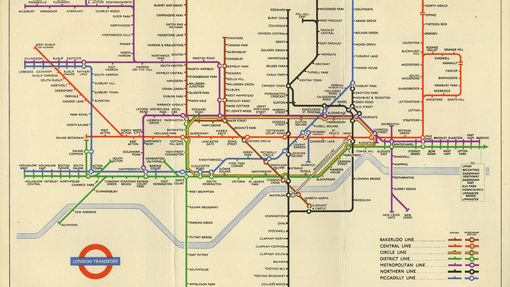
The Northern line
Key facts
Length: 61km
Stations: 52
Opened: 1890
Introduction

The Northern line serves some of the busiest commuter routes on the Underground, joining the suburbs of north and south London to the West End and the City. It has its origins in two early Tube railways – the City & South London Railway (C&SLR) and the Charing Cross, Euston & Hampstead Railway (CCE&HR). These were joined together in the 1920s and named the Northern line in 1937.
Why is it called the Northern line?
With its complex history, this line has undergone numerous name changes. It was named the Northern line in 1937 after the ambitious Northern Heights extension project of the period, which was ultimately never fully realised. This was also an attempt at a simplified name for a complicated line.
History
The C&SLR was the first electric tube railway in the world, opening in 1890, between Stockwell and King William Street near London Bridge. Stations had distinctive domed roofs to accommodate the winding gear of their hydraulic lifts.
The CCE&HR opened in 1907, the last of a group of three Tube lines sharing the oxblood-tiled stations of architect Leslie Green, known informally as the Hampstead Tube. Heading north from Charing Cross to Camden Town, the line then divided, with one branch to Golders Green and the other to Highgate.
Did you know?
Because the station is on a hill, the platforms at Hampstead are the deepest of any station on the Underground, at 58.2 metres
On early maps the CCE&HR was called the Hampstead Railway, then the Highgate and Hampstead line and later the Hampstead and Highgate line. In 1913, the C&SLR joined the umbrella company running the CCE&HR.
Work to connect the two railways started in 1922. New tunnels between Euston and Camden Town and Embankment and Kennington enabled a fully integrated service. Both lines also extended at this time, with the Hampstead line getting to Edgware in 1924 and the C&SLR to Morden in 1926. Morden station was the architect Charles Holden’s first big Underground commission and was to be the first of many.
In 1933 all of London’s underground railways came under public ownership, as part of London Transport (LT). Companies that had been named as Railways were now merely lines on the new map designed by Harry Beck.
The Northern was known as the Edgware, Highgate and Morden line in 1933, then the Morden-Edgware line a year later. Indecision over the name led people to suggest it should be named in the style of the Bakerloo, which had been the Baker Street and Waterloo Railway. Names like Mordenware or Edgmorden were proposed but didn’t catch on. In 1937 LT renamed it for the last time, after the ambitious Northern Heights extensions to Bushey and Elstree that were due to open in 1940.
Did you know?
Despite its name, the Northern line does not go to the most northerly station on the network. However, it does serve the station furthest south – Morden!
The new East Finchley station opened on schedule in July 1939, but the outbreak of the Second World War in September that year jeopardised LT’s bigger plans. Some work continued on local extensions over existing London & North Eastern Railway (LNER) lines, but High Barnet and Mill Hill East transferred to the Northern line without their planned re-builds. Charles Holden’s last complete station for the Underground, at Highgate, opened in January 1941.
During the war the site for the new railway depot at Elstree was converted to a factory making Halifax bomber aircraft engines and other parts. When the war ended, LT hoped their pre-war plans could still be realised, and the extensions remained on Underground maps as ‘under construction’ until 1949.
The extension plans also included a new fleet of ultra-modern trains – the 1938 Tube stock. 1,050 cars were built, but once the Northern Heights plans were formally abandoned in the early 1950s, 1938 stock trains started to appear on the Bakerloo and Piccadilly lines. The last 1938 stock trains were withdrawn from the Northern line when they were almost 50 years old in 1988.
In the 1960s and 1970s changes on the line were confined to improvements at interchanges like Euston and Charing Cross. In 1988 work started on the £55m rebuilding of Angel station and trains were diverted by 500 metres of new tunnels. The new station opened in 1993.
In September 2021, a new extension opened on the Northern line - the first major extension to the Underground this century.
The new extension, from Kennington to Nine Elms and the redeveloped Battersea Power Station, added 3km to the line.
Did you know?
Angel station on the Northern line has the Underground network’s longest escalator



















